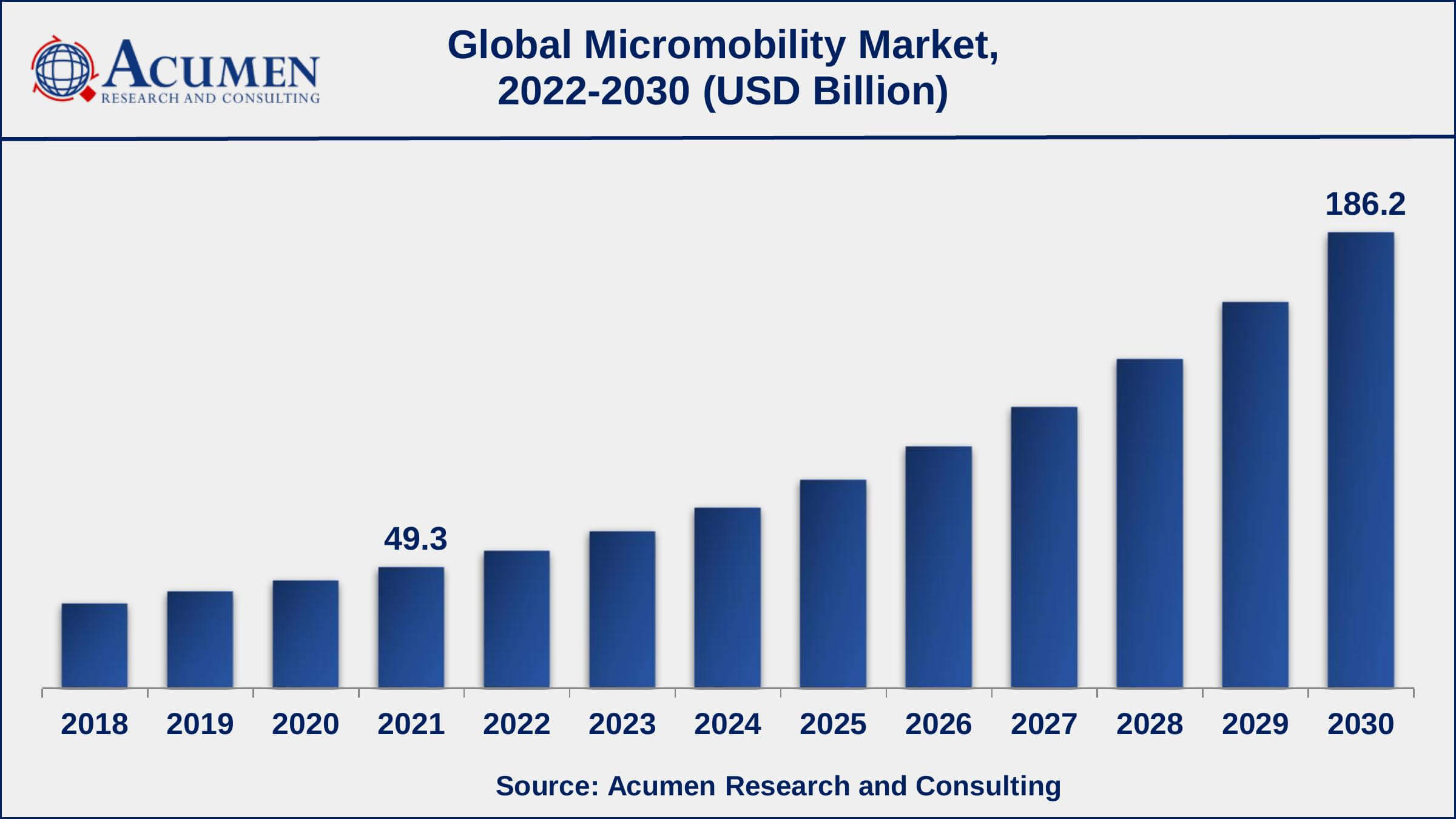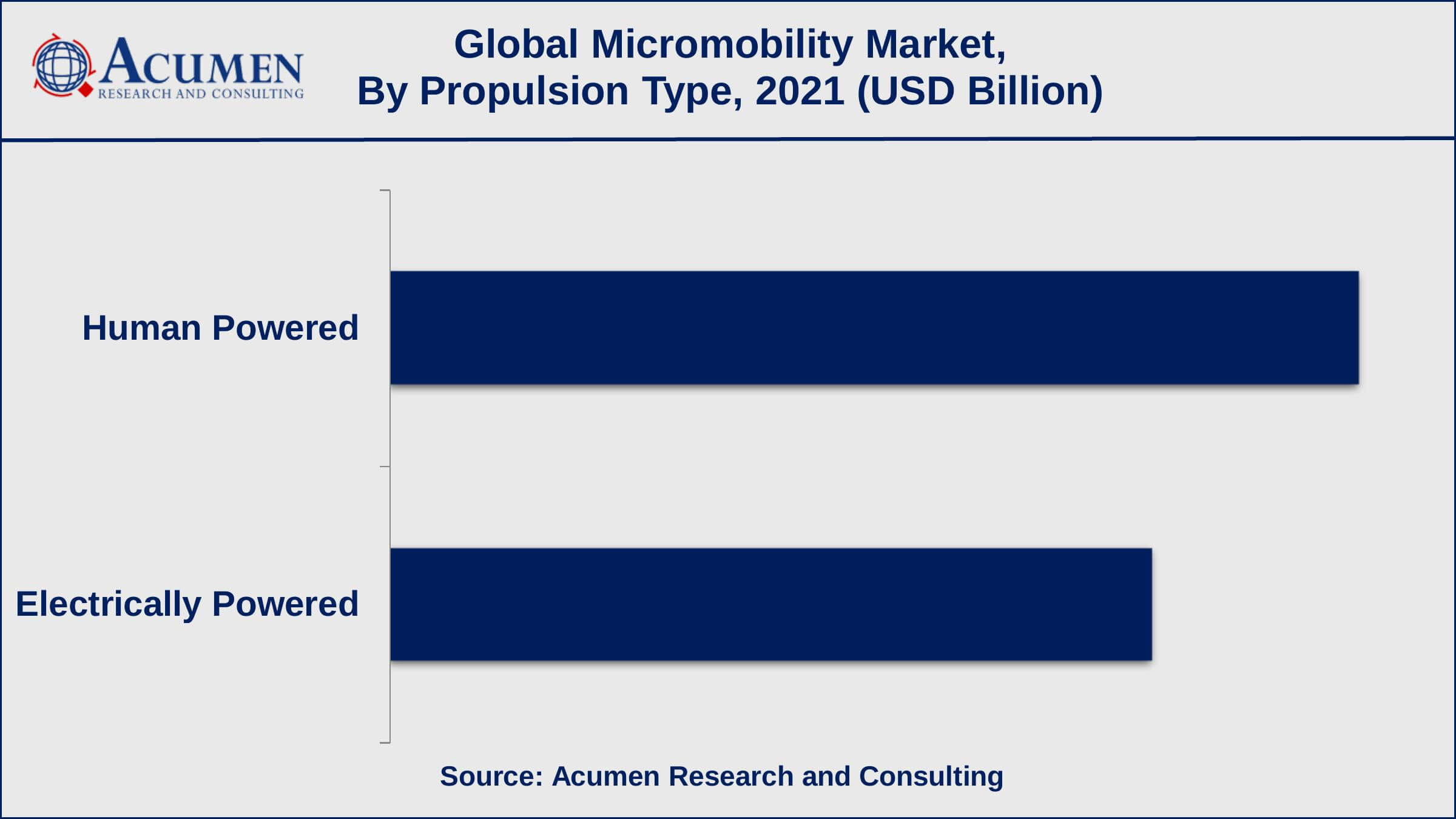Micromobility Market | Acumen Research and Consulting
Micromobility Market Size - Global Industry, Share, Analysis, Trends and Forecast 2022 - 2030
Published :
Report ID:
Pages :
Format :
The Global Micromobility Market Size gathered USD 49.3 Billion in 2021 and is set to garner a market size of USD 186.2 Billion by 2030 growing at a CAGR of 16.2% from 2022 to 2030.
Micromobility refers to small, lightweight, and easily maneuverable vehicles designed for short trips in urban areas, such as electric scooters, bikes, and hoverboards. Micro-mobility vehicles are designed for short trips and provide urban commuters with a convenient, quick, and cost-effective mode of transportation. These vehicles run on electricity, which makes them more environmentally friendly and reduces carbon emissions when compared to traditional gas-powered vehicles. More people choosing micro-mobility vehicles can help reduce traffic congestion in urban areas while also improving overall mobility. They can improve access to transportation for people who live in cities but do not have a car, such as the elderly, low-income households, and disabled people. Furthermore, micro-mobility vehicles can aid in the development of smart cities by providing an efficient and sustainable transportation solution that can aid in the reduction of urban congestion, the improvement of air quality, and the promotion of a cleaner and healthier environment.

Micromobility Market Report Statistics
- Global micromobility market revenue is estimated to reach USD 186.2 Billion by 2030 with a CAGR of 16.2% from 2022 to 2030
- Asia-Pacific micromobility market value gathered more than USD 22.2 Billion in 2021
- North America micromobility market growth will record a CAGR of more than 16% from 2022 to 2030
- Among propulsion type, the electrically powered sub-segment collected a 56% share in 2021
- Based on vehicle type, the bicycles sub-segment achieved US$ 20.7 billion in revenue in 2021
- The increased focus on sustainability is a popular micromobility market trend that drives the industry demand

Global Micromobility Market Dynamics
Market Drivers
- Rapid urbanization
- Increased environmental concerns
- Favorable government support
- Development of new technologies
Market Restraints
- Regulation and legal challenges
- Infrastructure challenges
- Limited range and battery life
Market Opportunities
- Expansion into new geographies
- Integration with public transportation
- Rising demand for last-mile transportation
Micromobility Market Report Coverage
| Market | Micromobility Market |
| Micromobility Market Size 2021 | USD 49.3 Billion |
| Micromobility Market Forecast 2030 | USD 186.2 Billion |
| Micromobility Market CAGR During 2022 - 2030 | 16.2% |
| Micromobility Market Analysis Period | 2018 - 2030 |
| Micromobility Market Base Year | 2021 |
| Micromobility Market Forecast Data | 2022 - 2030 |
| Segments Covered | By Propulsion type, By Vehicle Type, By Sharing Type, By Age Group, And By Geography |
| Regional Scope | North America, Europe, Asia Pacific, Latin America, and Middle East & Africa |
| Key Companies Profiled | Beijing Mobike Technology Co. Ltd, Bird Rides Inc., Boosted USA, DoorDash, Dynamic Bicycles, Easymile SAS, GoBike, GoJek, Lime, Micro Mobility Systems, Scoot Network, SEGWAY INC., Skip Transportation, and SWAGTRON. |
| Report Coverage |
Market Trends, Drivers, Restraints, Competitive Analysis, Player Profiling, Covid-19 Analysis, Regulation Analysis |
Micromobility Market Growth Factors
Increasing urbanization is a key factor that is driving the global micro-mobility market value. As cities continue to grow, there is an increased need for convenient, quick, and eco-friendly modes of transportation, leading to growth in the micro-mobility market. Environmental concerns are another factor that is boosting the micro-mobility industry. The increasing awareness about the impact of traditional modes of transportation on the environment is leading to a shift towards sustainable and eco-friendly modes of transportation, such as electric scooters and bikes. Governments in many countries are providing incentives and support for the adoption of micro-mobility vehicles, contributing to market growth.
Regulation and legal challenges are one of the restraining factors in the market. Different countries have different regulations and legal challenges related to the use of micro-mobility vehicles, which can limit their adoption and growth. In addition, many cities lack adequate infrastructure, such as bike lanes and charging stations, to support the widespread use of micro-mobility vehicles, which can hinder market growth. Besides that, there are safety concerns associated with the use of micro-mobility vehicles, such as accidents and injuries, which also restrict their adoption and growth.
Furthermore, advancements in technology, such as the development of lightweight and durable materials, have made micro-mobility vehicles more accessible and affordable, leading to an increase in demand. Finally, micro-mobility vehicles offer improved access to transportation for people who live in urban areas but don't have access to a car, such as the elderly, low-income households, and disabled individuals. This factor is expected to generate numerous growth opportunities for the market in the coming years.
Micromobility Market Segmentation
The worldwide micromobility market is categorized based on propulsion type, vehicle type, sharing type, age group, and geography.
Micromobility Market By Propulsion type
- Electrically Powered
- Human Powered

According to a micro-mobility industry analysis, the electrically powered sub-segment will have the greatest market share in 2021. This is due to a variety of factors, including their environmental friendliness, cost-effectiveness, and ease of use when compared to traditional modes of transportation. Furthermore, technological advancements such as longer-range batteries and improved charging infrastructure make electrically powered micro-mobility vehicles more accessible and convenient for urban commuters. The growing emphasis on sustainability and lowering carbon emissions is also driving the adoption of electrically powered micro-mobility vehicles, which is contributing to their market share growth.
Micromobility Market By Vehicle Type
- Bicycles
- E-Kick Scooters
- Hoverboard
- Low Speed EVs
- Skateboards
- Segway
- Mopeds and Scooters

In terms of vehicle type, the bicycle sub-segment is expected to account for a sizable market share in 2021. Bicycles have been around for a long time and are commonly used for transportation and recreation. The popularity of bicycles in the micro-mobility market has grown due to the rise of bike-sharing programmes and the growing demand for eco-friendly and cost-effective modes of transportation. Bicycles are also relatively inexpensive and simple to maintain, making them an appealing option for urban commuters. Furthermore, the growing emphasis on sustainability and reducing carbon emissions is driving bicycle adoption, contributing to their growing market share in the micro-mobility market.
Micromobility Market By Sharing Type
- Docked
- Dockless
The docked sharing type captured the most market share in the micro-mobility market. Docked sharing is a bike-sharing system in which bikes are rented from and returned to specific stations. This type of sharing system is popular because of its convenience and accessibility, as users can rent and return bikes from a variety of locations throughout the city. Furthermore, docked sharing systems typically have larger fleets and more established infrastructure, making them more convenient and dependable for users. The continued growth of eco-friendly and cost-effective transportation methods in urban areas has also contributed to the popularity of docked-sharing systems.
Micromobility Market By Age Group
- 15-34
- 35-54
- 55 and Above
According to the micromobility market forecast, the 35-54 age group is expected to hold the largest share from 2022 to 2030. The 35-54 age groups have a higher level of disposable income, which allows them to try new and innovative modes of transportation like micro-mobility vehicles. Additionally, this age group is often seeking convenient and eco-friendly transportation options for commuting or leisure activities, which aligns with the benefits offered by micro-mobility vehicles. Furthermore, the 15-35 age group is often referred to as the millennial or Gen Z population and they have been found to have the highest adoption rate of micro-mobility vehicles, such as electric scooters, bicycles, and e-bikes.
Micromobility Market Regional Outlook
North America
- U.S.
- Canada
Europe
- U.K.
- Germany
- France
- Spain
- Rest of Europe
Asia-Pacific
- India
- Japan
- China
- Australia
- South Korea
- Rest of Asia-Pacific
Latin America
- Brazil
- Mexico
- Rest of Latin America
The Middle East & Africa
- South Africa
- GCC Countries
- Rest of the Middle East & Africa (ME&A)
Micromobility Market Regional Analysis
The Asia-Pacific region was a major micromobility market with significant growth potential. China, Japan, and India were three of the leading countries in the Asia-Pacific micro-mobility market, driven by rising urbanization and a desire for more convenient, environmentally friendly and cost-effective modes of transportation. Bicycles and electric scooters were the most popular vehicle types in the Asia-Pacific micro-mobility market, owing to their popularity, low cost, and environmental friendliness. Factors such as increasing urbanization, a growing emphasis on sustainability, and increasing adoption for last-mile transportation solutions are driving the Asia-Pacific micro-mobility market. The region is also expected to witness a substantial growth rate in the coming years. In addition, North America and Europe were significant market for micro-mobility, with a growing demand for convenient and eco-friendly modes of transportation.
Micromobility Market Players
Some of the leading micromobility companies include Beijing Mobike Technology Co. Ltd, Bird Rides Inc., Boosted USA, DoorDash, Dynamic Bicycles, Easymile SAS, GoBike, GoJek, Lime, Micro Mobility Systems, Scoot Network, SEGWAY INC., Skip Transportation, and SWAGTRON.
Frequently Asked Questions
What was the market size of the global micromobility in 2021?
The market size of micromobility was USD 49.3 Billion in 2021.
What is the CAGR of the global micromobility market during forecast period of 2022 to 2030?
The CAGR of Micromobility market is 16.2% during the analysis period of 2022 to 2030.
Which are the key players operating in the market?
The key players operating in the global market are Beijing Mobike Technology Co. Ltd, Bird Rides Inc., Boosted USA, DoorDash, Dynamic Bicycles, Easymile SAS, GoBike, GoJek, Lime, Micro Mobility Systems, Scoot Network, SEGWAY INC., Skip Transportation, and SWAGTRON.
Which region held the dominating position in the global micromobility market?
Asia-Pacific held the dominating position in micromobility market during the analysis period of 2022 to 2030.
Which region registered the fastest growing CAGR for the forecast period of 2022 to 2030?
Asia-Pacific region exhibited fastest growing CAGR for micromobility market during the analysis period of 2022 to 2030.
What are the current trends and dynamics in the global Micromobility market?
The current trends and dynamics in the micromobility industry include rapid urbanization, increased environmental concerns, favorable government support, and development of new technologies.
Which propulsion type held the maximum share in 2021?
The electrically powered propulsion type held the maximum share of the micromobility market.



